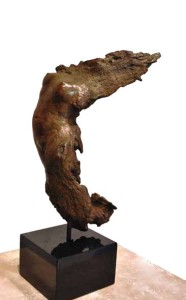Ask The Expert Harmon Meek
Dear Artspert:
My husband and I were talking today about bronze sculpture. When an artist has a foundry create a bronze is it still a unique piece of original art? We were wondering how bronze sculptures are made? What are the different things we should look for when we see a bronze sculpture?
Signed, Living in the Bronze Age
Dear Bronze Age,
 Metal sculptures can be created in steel, stainless steel, aluminum, iron, bronze, copper, and many other various alloys. Depending upon the creator’s desires, they can be made as standalone works or in multiple copies called “editions”. For many centuries most metal sculptures have been made out of bronze, which is copper and tin, and is usually cast from molds. The two most usual forms of casting are “sand” molds and “lost-wax” molds.
Metal sculptures can be created in steel, stainless steel, aluminum, iron, bronze, copper, and many other various alloys. Depending upon the creator’s desires, they can be made as standalone works or in multiple copies called “editions”. For many centuries most metal sculptures have been made out of bronze, which is copper and tin, and is usually cast from molds. The two most usual forms of casting are “sand” molds and “lost-wax” molds.
Without getting too technical, essentially in sand molds an existing stone, metal, or wood object has its form pressed into a sand box and then removed before the molten bronze is poured into the mold. With “lost-wax” technique the artist creates the sculpture in a modeling wax; which after molding in a plaster, the molten bronze melts away the wax and takes its same form.
The question of uniqueness of bronzes relates to the term “edition”. It is possible for an artist to create a single, unique bronze, but it is more typical for a sculptor to produce a single sculpture in a limited, numbered edition of identical multiples. Prior to the 20th century bronze editions were not regulated by any self-imposed rule. For example the most famous Edgar Degas ballet dancer “Little Dancer of Fourteen Years” from 1881 was cast using lost-wax after the artist’s death and twenty-eight are known to exist. Today U.S.
Customs allows editions of 10 or fewer to travel as fine art, without duty in and out of this country as if were “unique”. Any numbered editions beyond ten would be subject to a duty as a “multiple”.
Because of the high costs associated with casting bronze, many sculptors have had their sculpture cast in Italy, not only for cost savings but also for Italy’s centuries old expertise.
Additionally many sculptors today lower the retail selling prices by creating editions of 25, 50, 75, 100 or more. This does not infer that these higher editions are to be avoided just know that when it comes time to sell those works there are possibly many others competing to sell their same sculpture.
O f course there are also fake bronzes, known in the art world as “surmolages”. Most typically these appear in highly desired works such as Frederic Remington bronzes. These restrikes are made from original bronzes and are fractionally smaller than the originals.
There are also “pot–metal” bronzes cast by the hundreds that show up in decorator and quasi-antique shops which should only be purchased as inexpensive lawn or interior decorations and not confused with fine art.
Bronzes should carry the foundry name, artist’s signature, edition size and number of the piece in hand such as 6/9 or VI/IX and possibly the date. Sometimes these markings, made when the piece is cast, are very obscure or faint and sometimes on the underside and covered by a marble base the bronze sits atop.
Bronzes may also come in different colors called “patina” created by specially mixing combinations of chemicals that are painted on by brush after the bronze has been molded and heated by flame torch. The patina of a bronze can also be affected by the elements it is exposed to such as salt air (turns black), uric acid (turns green), repeated hand touching (polishes to shiny gold luster), normal exposure (turns dark brown).
Sincerely, The Artspert
599 Ninth Street North Suite 309 | Naples, FL 34102 | 239-261-2637 239-261-2637
239-261-2637
A Primer on the various types of Prints www.harmonmeek.com



Leave a Reply
Want to join the discussion?Feel free to contribute!